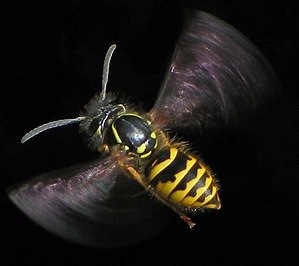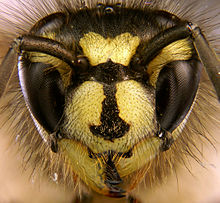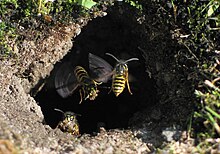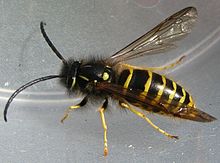Common wasp
| Common wasp | ||||||||||||
|---|---|---|---|---|---|---|---|---|---|---|---|---|

Common wasp ( Vespula vulgaris ) |
||||||||||||
| Systematics | ||||||||||||
|
||||||||||||
| Scientific name | ||||||||||||
| Vespula vulgaris | ||||||||||||
| ( Linnaeus , 1758) |
The common wasp ( Vespula vulgaris ) is a wasp species from the genus of the short-headed wasps ( Vespula ) and thus belongs to the real wasps (Vespinae). Besides the German wasp ( Vespula germanica ) it is one of the most common wasp species in Central Europe .
features
The queens of the common wasp grow up to 20 millimeters long. The workers are much smaller at eleven to fourteen millimeters. The drones reach body lengths of thirteen to seventeen millimeters.
The common wasp can be distinguished from the very similar German wasp based on the drawing on the front plate (clypeus). While the German Wasp has one to three linearly arranged black dots or a small, straight, often interrupted black line, there is a broad black line on the forehead plate of the Common Wasp that thickens towards the bottom. The yellow-black abdominal markings are very variable and therefore do not allow a reliable identification of the species.
Way of life
nutrition
The adult animals ( Imagines ) feed primarily vegetarian of nectar and other sugary plant juices. The larvae are fed with insects chewed into pulp or other animal protein. When searching for food, the common wasps often find themselves on cakes or other sugary foods of humans and are difficult to drive away from this food source, once they have been discovered for themselves.
Nest building
From mid-April, mated females, the queens, can be observed searching for nests and food. The nectar of willow blossoms serves as a food source during this time . After about two to three weeks of feeding and searching for a nesting site, the common wasp builds its nest from chewed, saliva-lined wood fibers in dark, protected places.
Often the nests are created underground in mice or mole burrows, which are expanded as the nest size increases. The inhabitants of these nests are popularly known as "earth wasps". But attics, roller shutter boxes or other dark cavities on and in buildings are also used to build nests. The initial nest consists of seven brood cells (one in the middle, six cells around it), which are attached to the ceiling hanging upside down and surrounded by a spherical nest shell. The common wasp uses rotten wood from rotting tree trunks or branches to build nests, which gives their nest a light, beige-colored appearance. The closely related German wasp, on the other hand, gnaws off the surface of weathered wood (e.g. from willow stakes or wooden fences), which is why their nest is rather greyish in color.
Founding of the state
The queen lays an egg in each of the brood cells , which she inseminates with sperm from the receptaculum seminis (seminal bag) shortly before laying the eggs , in which she carries a sperm store from last autumn with her. The brood care and nest building are carried out in this phase by the queen, who is on her own. She feeds the larvae with a pulp made from chewed insects. After feeding, the larvae release a drop of sugary liquid, which in turn serves to nourish the queen and is the only way for the larvae to release liquid. Only shortly before pupation do the larvae give off feces. This prevents rotting in the nest due to contamination with excretions. Due to the pheromones exuded by the queen, no new fertile females develop from the larvae, but only sterile workers, to whom the queen hands over the further construction of the nest and the procurement of food. After that the queen only devotes herself to reproduction. The workers create brood combs on several levels.
Wasp state
Their number and thus the size of the nest increases rapidly and usually increases to 3,000 to 4,000 individuals, with the nests growing continuously until late summer. With the onset of the production of new sex animals (in special, somewhat enlarged cells) in late summer or early autumn, the maximum size is reached. From then on the number of individuals decreases rapidly as no new workers are produced until the nest dies in autumn. The colony size reaches around 500 to 5000 workers, the nest then has around 3500 to a maximum of around 15000 brood cells. Lower maximum strengths, up to 8500 brood cells, are given for Japan. Larger colonies exist in New Zealand, where the species was carried off by humans and where colonies can exceptionally overwinter, up to 20,000 brood cells have been counted here.
The entire state is organized according to the division of labor, which means that the individuals are either occupied with building nests, cleaning cells, feeding larvae, caring for the queen or procuring food. The brood care is as intensive as with the bees . In contrast to these, there is no wagging dance in the wasps as communication about the distance and direction of a possible source of food.
Due to a reduced release of pheromones by the queen and the improved care of the larvae, fertile females develop in late summer or autumn, the queens of the new generation. Males (drones) develop from unfertilized eggs and die after mating. To avoid inbreeding , some of the males also leave the nest and look for fertile females from other colonies to mate with.
Downfall and new beginning
The old queen usually dies in late autumn, and her wasp state then dissolves. When the cold snaps, the last homeless workers of the old state also die. Only the mated young queens look for a protected hiding place. In a suitable microclimate such as rotten wood, in cavities, under bark or moss, they survive the winter asleep in a paralysis called diapause . In the following spring, the young queen founds a new state by starting again with building nests in a suitable place.
Attack and defense
The wasps use their sting to overwhelm and paralyze a possible insect prey or to ward off a troublemaker or attacker. During the sting process, the sting is extended out of the sting chamber in the gaster, in which it is hidden in the resting position, and pressed onto the victim, with the wasp holding onto its legs. The two piercing bristles (or lancets) are alternately moved back and forth in rapid motion by a vibrating movement of the sclerite that fixes the sting, anchoring themselves in the skin through their barbs and pulling the whole sting deeper and deeper into the puncture site. The three parts of the sting are coupled to one another by fold-like connections, but can be moved against one another for the lancing process. The poison is applied to the wound from the reservoir of the poison bladder through a central channel in the sting, which is delimited by the two piercing bristles and the prickly sheath. In contrast to the bees , the third component of the sting, the sting sheath, does not have barbs . The shape of the barbs allows easier withdrawal, and the stinging apparatus is more firmly anchored in the gaster than in bees by means of joints and muscles. That is why wasps can stab as often as they want and inject their venom in the process. The sting reflex is still present even in animals that have been cut up or have just died.
See also : insect bite
Harmful effect
Effect on people
Together with the German wasp, which shares a human preference for food and drinks, the common wasp has given the wasps a generally bad reputation. The common wasp is considered a nuisance . In addition, in addition to their tenacity, the two species are also defensive if, for example, you unintentionally approach their nest or if they feel threatened by violent movements. When they sting , alarm pheromones are released, which attract other animals and encourage them to sting. The poison causes an allergic reaction in some people .
Effect on the ecological balance
The common wasp was inadvertently introduced into New Zealand in the early 1980s after the German wasp had been naturalized there since around 1945. Due to the lack of natural enemies there and a year-round mild climate, at least in some regions, both species of wasp have multiplied rapidly in their new home. The common wasp almost completely displaced the German wasp that was introduced in front of it. The common wasp prey on any other insect that it can overwhelm in the canopy of trees or on the forest floor. This has made it a significant threat to native species there. So it is as a food competitor a major threat factors of Kaka , one as threatened ( endangered ) classified Parrot Art.
literature
- Rolf Witt: Observe wasps, determine . Naturbuch / Weltbild, Augsburg 1998, ISBN 3-89440-243-1
- Heiko Bellmann : bees, wasps, ants. Hymenoptera of Central Europe . Franckh-Kosmos, Stuttgart 1995, ISBN 3-440-06932-X
- Jiří Zahradník: bees, wasps, ants. The hymenoptera of Central Europe . Franckh-Kosmos, Stuttgart 1985, ISBN 3-440-05445-4
Individual evidence
- ↑ School class attacked by earth wasps. In: steiermark.orf.at. October 2, 2013, accessed December 1, 2017 .
- ^ Roger F. Akre & Harry G. Davis (1978): Biology and pest status of venomous wasps. Annual Review of Entomology 23: 215-238.
- ^ Makoto Matsuura & Seiki Yamane (1984): Biology of the Vespinae Wasps. Springer Verlag, Berlin etc. 1984. ISBN 3-540-51900-9 .
- ↑ DM & PL Leathwick Godfrey (1996): overwintering colonies of the common wasp (Vespula vulgaris) in Palmerston North, New Zealand. New Zealand Journal of Zoology 23: 355-358.
Web links
- More pictures and information
- Vespula vulgaris at Fauna Europaea



